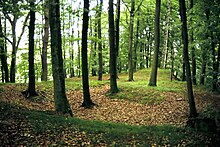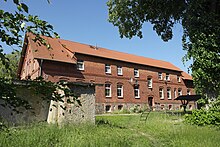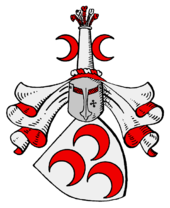Bodenhausen (noble family)
Bodenhausen is the name of a noble family originally from Lower Saxony . Later the Lords of Bodenhausen also acquired property and prestige in Hesse , Braunschweig , Anhalt , Saxony and Prussia . Branches of the family still exist today. The line that used to be in Hesse is still a member of the Old Hessen Knighthood .
history
origin

The family appears for the first time with Teginhardus de Bodenhusen, who is mentioned in documents from 1135 to 1150. The trunk row begins with him . 1186 a Heinrich von Bodenhausen is mentioned in a document on the Rusteberg. Another early bearer of the name was, after Johann Georg Leuckfeld, the knight Heinrich von Bodenhausen, who appears as a witness in a diploma that Duke Albrecht of Braunschweig issued to the Pöhlde monastery in 1297 . Cyriacus Spangenberg names Johann von Bodenhausen 1360 as "Derectorum Doctor" and canon of Erfurt .
The original ancestral seat of the family is probably the Bodenhausen castle of the same name near Ballenhausen , today part of the Friedland community in the Göttingen district . In older literature, a Bodenhausen farm near Ehlen , now part of the Habichtswald community , is mentioned.
Expansion and possessions





Bruno von Bodenhausen was enfeoffed in 1318 by Duke Otto the Milden, among others with the Vogtei in Niedergandern ; the manor there with its ancillary Reckershausen has remained in the family's possession to this day.
In 1373 Heiligenstadt in Thuringia was owned or partially owned by the family. In Niederhessen , the family expanded considerably and in 1560 acquired Arnstein Castle near Witzenhausen and in 1614 Mühltroff Castle in Vogtland . Arnstein Castle remained in the family's possession until 1938.
During the 18th century, further possessions were added in Electoral Saxony (including Niedertrebra ). In Anhaltisches the family in the 17th and 18th centuries was wealthy and the 19th century was still middle with Trebbichau invested . Relatives were temporarily also in the Altmark , Westphalia and Silesia , later mainly in Kurhessen .
Melchior von Bodenhausen, Lord of Arnstein and Niedergandern and grandson of Heinrich von Bodenhausen and Catharina von Kerstlingerode, was Landgrave Hessian councilor at the Diet of Worms in 1521 . His sons Otto Heinrich and Wilke continued the tribe. Otto Heinrich's son, Lord of Arnstein and Wülfingerode among others , Krafft von Bodenhausen, became councilor of the Electorate of Mainz and Saxony, assessor of the district court on the Eichsfeld, Colonel on Ross and captain of the offices of Torgau and Liebenwerda . Cuno Odomar von Bodenhausen, grandson of Otto Heinrich, became a member of the Fruit- Bringing Society under the name of "the Comfortable".
A Hans von Bodenhausen was in the middle of the 17th century electoral Saxon upper court marshal and Otto von Bodenhausen was princely privy councilor in Brandenburg-Culmbach around the same time . Melchior Otto von Bodenhausen, Lord of Mühltroff in the Vogtland, married a daughter from the Silesian noble family von Reiswitz and thereby acquired the Grabowka manor near Ratibor in Upper Silesia .
In the 17th century Melchior von Bodenhausen (son of Wilke) acquired the Leubnitz estate from Hildebrand Eichelberg Trützschler. As a result, a legal dispute broke out with the heirs of Leonhard von Milkau zu Christgrün because of the grant of 2000 guilders in addition to the accrued interest against the co-leaned Wolff Wilhelm Trützschler owner ( Trützschler ). The legal dispute began in 1616 and dragged on until a final settlement between the Milkau heirs and Franz Wilke von Bodenhausen (son of Otto von Bodenhausen) in 1645.
Around 1700 Kraft Burchhard von Bodenhausen acquired the Brandis manor in Saxony; his son Otto Wilhelm von Bodenhausen had Brandis Castle built between 1724 and 1727 according to plans by David Schatz .
From 1911 to 1945 the Mecklenburg Gut Helpt belonged to Bodenhausen.
Status surveys
On August 2, 1669 in Vienna , Franz Wilke von Bodenhausen received the status of imperial baron on Arnstein, Mühltroff and Leibnitz .
Ernst Ludwig Carl Mordian von Bodenhausen (1785-1854) received as a chamberlain at the court of Jérôme Bonaparte on March 6, 1812 together with his two younger brothers the elevation to the baron class in the Kingdom of Westphalia .
Hans von Bodenhausen, Fideikommissherr on Degenershausen , and the respective owner of the Fideikommiss and descendant of his parents, received on June 6, 1859 in Berlin the Prussian approval to use the name of Bodenhausen called Degener . He and his brothers Julius and Bodo von Bodenhausen received on December 15, 1869 in Berlin, Conrad von Bodenhausen (zu Abtsdorf), later Vice Admiral, on May 28, 1870 in Berlin and the other members of the Radis family on June 10, 1874 Berlin received the Prussian authorization to use the title of baron.
A Anhalt permit to use the title of baron for Bodo von Bodenhausen auf Radis, ducal Anhalt chamberlain , was granted on May 1, 1875.
Arthur von Bodenhausen, Fideikommissherr auf Reckershausen , obtained a Prussian permit in London on July 12, 1891 to continue the title of baron.
On October 2, 1912, Arthur Freiherr von Bodenhausen, royal Saxon lieutenant colonel , and Gustav Freiherr von Bodenhausen, royal Saxon major and later Fideikommissherr in Niedergandern , were entered in the royal Saxon nobility book under number 416.
coat of arms
Blazon of the family coat of arms : “In silver three (2: 1) increasing, red crescent moon . On the silver-red bulging, looking pot helmet (on a leaning shield) with red-silver blankets, a growing , conical, silver column topped with three red and two silver cock feathers alternately, set on the side with an increasing and decreasing red crescent moon. "
Due to the similarity of the coat of arms, a tribal relationship with the von Hanstein from neighboring Eichsfeld is likely.
Known family members
- Heinrich and Günther von Bodenhausen, bailiffs on the Rusteberg (1393)
- Margaretha von Bodenhausen, Abbess of the Beuren Abbey (1519–1537)
- Hans von Bodenhausen (officer) (1606–1684), royal Danish officer
- Hans von Bodenhausen (politician) (1841–1921), German lawyer and district administrator, member of the German Reichstag
- Hans von Bodenhausen-Degener (1839–1912), German manor owner and member of parliament
- Otto Wilhelm von Bodenhausen (1680–1754), district chief of Leipzig
- Ernst von Bodenhausen (1785–1854), Hanoverian envoy in Vienna
- Rudolph Woldemar von Bodenhausen (1826–1900), first lieutenant and member of the state parliament
- Julius von Bodenhausen (1840–1915), member of the German Reichstag
- Conrad von Bodenhausen (1848–1938), German Vice Admiral, 1902/11 Reichskommissar at the Hamburg Sea Office
- Cuno von Bodenhausen (1852–1931), painter
- Arthur von Bodenhausen (1859–1914), major general
- Bodo von Bodenhausen (lawyer) (1633–1700), German lawyer, court official and manor owner
- Bodo Friedrich von Bodenhausen (1705–1781), Bremen-Verdean minister
- Bodo von Bodenhausen (Lieutenant General) (1836–1919), Prussian Lieutenant General
- Bodo von Bodenhausen (District Administrator) (1860–1911), German administrative officer and manor owner
- Edwin von Bodenhausen (1860–1920), Prussian lieutenant general
- Eberhard von Bodenhausen called Degener (1868–1918), art historian of Viennese modernism
- Kraft von Bodenhausen (1871–1952), politician
- Dora von Bodenhausen (1877–1969), wife of Eberhard von Bodenhausen
- Erpo von Bodenhausen (1897–1945), German lieutenant general
- Luli von Bodenhausen (Julie Dorothea Baroness von Bodenhausen; 1902–1951), actress and author
Witnesses in kind
In the church of Radis there is a sandstone grave slab with an inscription and 2 × 8 coats of arms for Cune von Bodenhausen (1601–1637) on the south wall of the choir, and an analogous plate for Curd von Bodenhausen (1604–1632) on the north wall of the choir. Both grave slabs are simple stone carvings that are very well preserved.
literature
- Ernst Heinrich Kneschke : New general German nobility lexicon . Volume 1, Friedrich Voigt's Buchhandlung, Leipzig 1859, pp. 508-510. ( books.google.de )
- Arthur von Bodenhausen: genealogical tables of the von Bodenhausen family with documents. Dieterich, Göttingen 1865. ( digitized version )
- Leopold von Zedlitz-Neukirch : New Prussian Adelslexicon . Volume 1. Reichenbach Brothers, Leipzig 1836, pp. 265–266. ( books.google.de )
- Genealogisches Handbuch des Adels , Adelslexikon Volume I, Volume 53 of the complete series. CA Starke Verlag, Limburg (Lahn) 1972, ISSN 0435-2408
- Carl Hermann Richter: The rule Mühltroff and their owners. Teubner, Leipzig 1857, p. 47ff.
- Otto Posse: The seal of the nobility of the Wettin region. Volume II, Verlag Wilhelm Baensch Dresden 1906, pages 55-57
Web links
Individual evidence
- ↑ Genealogical tables of the von Bodenhausen family, Göttingen 1865
- ↑ RIplus Regg. EB Mainz 2 [after 382], in: Regesta Imperii Online, URI: http://www.regesta-imperii.de/id/c9f454e1-c2d9-41a7-88b5-ac52fa86db47 (accessed on August 21, 2017)
- ↑ Johann Georg Leuckfeld : Anitiquit. Poeldens. P. 90.
- ↑ Niedertrebra in the castle archive
- ↑ Main State Archives Dresden 10084, Court of Appeal Dresden, No. 666
- ^ Directory of confirmations of nobility in the former Königr. Westphalia. In: Der deutsche Herold 6 (1875), p. 132
- ↑ Hans-Joachim Böttcher : Historical grave monuments and their inscriptions in the Dübener Heide . Ed .: AMF. tape 165 , August 2005, p. 30-31 .
